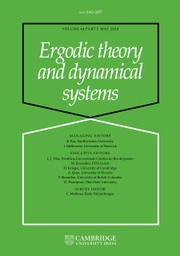Article contents
STIT tessellations are Bernoulli and standard
Published online by Cambridge University Press: 29 November 2012
Abstract
Let (Yt:t>0) be a STIT tessellation process and a>1. We prove that the random sequence (anYan:n∈ℤ) is a non-anticipating factor of a Bernoulli shift. We deduce that the continuous time process (atYat:t∈ℝ) is a Bernoulli flow. We use the techniques and results in Martínez and Nagel [Ergodic description of STIT tessellations. Stochastics 84(1) (2012), 113–134]. We also show that the filtration associated to the non-anticipating factor is standard in Vershik’s sense.
- Type
- Research Article
- Information
- Copyright
- ©2012 Cambridge University Press
References
[1]Blumenthal, R. M. and Getoor, R. K.. Markov Processes and Potential Theory. Academic Press, New York and London, 1968.Google Scholar
[2]de la Rue, T.. Espaces de Lebesgue. Séminaire de Probabilités de Strasbourg XXVII (Lectures Notes in Mathematics, 1557). Springer, Berlin, 1993, pp. 15–21.CrossRefGoogle Scholar
[3]Émery, M. and Schachermayer, W.. On Vershik’s standardness criterion and Tsirelson’s notion of cosiness. Séminaire de Probabilités, XXXV (Lecture Notes in Mathematics, 1755). Springer, Berlin, 2001, pp. 265–305.CrossRefGoogle Scholar
[4]Ethier, S. N. and Kurtz, T. G.. Markov Processes. John Wiley & Sons, New York, 1985.Google Scholar
[5]Feldman, J. and Smorodinsky, M.. Decreasing sequences of measurable partitions: product type, standard and prestandard. Ergod. Th. & Dynam. Syst. 20(4) (2000), 1079–1090.Google Scholar
[6]Lachièze-Rey, R.. Strong mixing property for STIT tessellations. Adv. Appl. Prob. 43(1) (2011), 40–48.CrossRefGoogle Scholar
[7]Martínez, S. and Nagel, W.. Ergodic description of STIT tessellations. Stochastics 84(1) (2012), 113–134.Google Scholar
[8]Mecke, J., Nagel, W. and Weiß, V.. A global construction of homogeneous random planar tessellations that are stable under iteration. Stochastics 80 (2008), 51–67.Google Scholar
[9]Nagel, W. and Weiß, V.. Crack STIT tessellations: characterization of stationary random tessellations stable with respect to iteration. Adv. Appl. Prob. 37 (2005), 859–883.Google Scholar
[10]Ornstein, D.. Bernoulli shifts with the same entropy are isomorphic. Adv. Math. 4 (1970), 337–352.Google Scholar
[11]Ornstein, D.. Two Bernoulli shifts with infinite entropy are isomorphic. Adv. Math. 5 (1970), 339–348.CrossRefGoogle Scholar
[12]Ornstein, D.. Factors of Bernoulli shifts are Bernoulli shifts. Adv. Math. 5 (1970), 349–364.Google Scholar
[13]Ornstein, D.. Ergodic Theory, Randomness and Dynamical Systems. Yale University Press, New Haven, CT, 1974.Google Scholar
[14]Schneider, R. and Weil, W.. Stochastic and Integral Geometry. Springer, Berlin, 2008.Google Scholar
[15]Vershik, A. M.. The theory of decreasing sequences of measurable partitions. St. Petersburg Math. J. 16(2) (1995), 705–761. Expandend version of doctoral thesis, Leningrad University, 1973.Google Scholar
- 2
- Cited by


